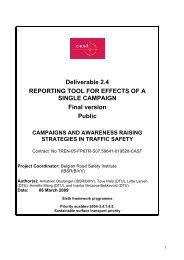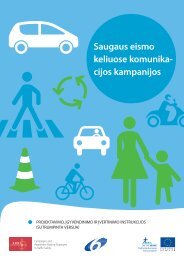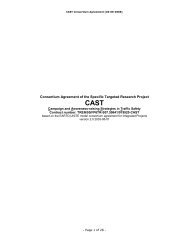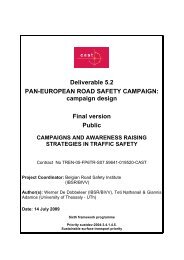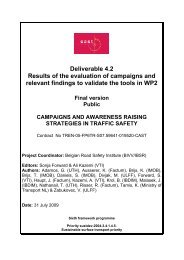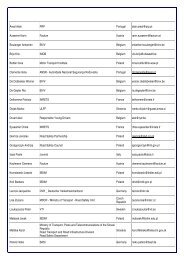Deliverable D 1.3 RESULTS OF META-ANALYSIS ... - cast-eu.org
Deliverable D 1.3 RESULTS OF META-ANALYSIS ... - cast-eu.org
Deliverable D 1.3 RESULTS OF META-ANALYSIS ... - cast-eu.org
Create successful ePaper yourself
Turn your PDF publications into a flip-book with our unique Google optimized e-Paper software.
Campaigns and awareness raising strategies in traffic safety — <strong>Deliverable</strong> D-1.1Only a minority (31 per cent) of the campaigns had an explicit basis, and lessthan 20 per cent were based on a psychosocial theory or model. Thishindered our ability to assess the influence of a particular model on campaigneffects.The factor ‘emotional content’ remained necessarily vague while links todetailed campaign content was not available in the evaluation studies. Wewould particularly like to encourage the explicit documentation of theemotional content of a campaign. Cross-referencing campaign documentationwould help.We were particularly surprised at the lack of campaigns evaluated that wereexplicitly shocking Very few conclusions could be drawn about the ‘use of fear’in campaigns, and we would encourage more evaluation of these types ofcampaigns.Evaluation studies often fail to report exactly when, in relation to the campaignperiod, measurements are taken. This prevented an analysis of possibledeterioration of campaign effects over time. Furthermore, the reporting bymany studies of measurements in simple terms (often as ‘before’ or ‘after’values), encouraged the comparison of all before-after effects, even thoughthe after effect may be taken 1 day or several months following campaigncompletion. We strongly recommend that after measures be reported aslevels x days following campaign initiation and/or completion, not only in theresults sections but in all Figures and Abstracts.Finally, attempts are made in <strong>Deliverable</strong> 1.4 of this Work Package toconsider different models of road user behaviour, and how they can be usedto predict behaviour, and in turn influence accidents. For instance, the Theoryof Planned Behaviour would predict that campaigns should influencebehaviour through intentions to behave and, in turn, through attitudes,perceived outcome and social norms. In our experience it is difficult toevaluate these models using the current evaluation studies. Although a poorrelationship was found between attitudes and campaigns, the psychometricqualities of the attitude measures used by evaluation studies are on the wholevery poor. In addition, study evaluations simply do not provide enoughinformation about affect or perceived social norms to enable their evaluation.These findings would seem to strengthen the call for standardisation ofcampaign evaluations based on constructs representing a wide range of themost feasible models.118



